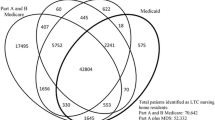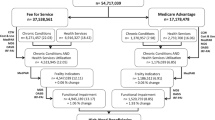Abstract
Nursing facilities provide skilled nursing and rehabilitative care to patients for short stays and custodial care to patients for long stays. The type of nursing facility stay (short- or long-term) is a potentially important risk factor and health outcome in health services research and is informative from both medical and fiscal perspectives. The purpose of this study was to develop and validate an algorithm to identify the use of nursing facility services and differentiate short- from long-term care using Medicare claims data. We used claims data for a 5% sample of Medicare beneficiaries to develop an algorithm to detect the use of nursing facility services and to distinguish between short- and long-term stays. We tested this algorithm using residency status from Medicaid long-term care claims for dually eligible beneficiaries and using residency status from the Medicare Current Beneficiary Survey (MCBS). Among 1,694,051 beneficiaries included in the baseline cohort, 25.6% had some indication of nursing facility residency. Using our algorithm, 59.8% of beneficiaries using any nursing facility care were classified as long-term residents. Validation of the algorithm against Medicaid long-term care claims and MCBS yielded high sensitivity and specificity. To our knowledge, this is the first paper to present a validated algorithm for identification of use of nursing facility services among Medicare beneficiaries that differentiates between short- and long-term care residency status.

Similar content being viewed by others
References
Boaz, R.F., Muller, C.F.: Predicting the risk of “permanent” nursing home residence: the role of community help as indicated by family helpers and prior living arrangements. Health Services Res. 29, 391–414 (1994)
BUCCANEER. Chronic Condition Data Warehouse User Manual. Version 1.4 September 2008 http://www.ccwdata.org/downloads/CCW%20User%20Manual.pdf. Accessed on Jan 6, 2009
Coughlin, T.A., McBride, T.D., Liu, K.: Determinants of transitory and permanent nursing home admissions. Med. Care 28, 616–631 (1990)
Hatten, J.: Medicare’s common denominator: the covered population. Health Care Financing Review. Fall, 53–64 (1980)
Iwashyna, T.J.: On the detection of nursing home use in Medicare claims. Health Services Outcomes Res. Methodol. 4, 187–196 (2003)
Medicare Current Beneficiary Survey. http://www.cms.hhs.gov/MCBS/. Accessed on Jan 4, 2009
Research Data Assistance Center. Accessed from Jan 6, 2009 http://www.resdac.umn.edu/MDS/data_available.asp
Sloan, F.A., Shayne, M.W.: Long-term care, Medicaid, and impoverishment of the elderly. Milbank Q. 71(4), 575–599 (1993)
Zuckerman, I.H., Sato, M., Hsu, V.D., Hernandez, J.J.: Validation of a method for identifying nursing home admissions using administrative claims. BMC Health Services Res. 7, 202 (2007). doi:10.1186/1472-6963-7-202
Author information
Authors and Affiliations
Corresponding author
Additional information
This research was supported by a contract between UAB and Amgen, Inc. Only the authors from UAB had access to the Medicare data used. The analysis, presentation, and interpretation of the results were solely the responsibility of the authors.
Appendices
Appendix
The algorithm used in the manuscript to identify long-term residency status was derived from an investigation of alternative specifications which were arrayed according to the strength of the evidence for nursing home residency. Each of these specifications depended on a Nursing Facility Indicator calculated for each month of observation for each Medicare beneficiary.
Nursing facility indicator
The nursing facility indicator was initiated in the first month that a beneficiary had at least one nursing facility related CPT or POS code and no SNF claim. After the initial month that identified a beneficiary as a long term resident, SNF claims were not treated as evidence of short term stays—since residents might become eligible for acute care covered by Medicare, especially after an acute hospitalization.
Cumulative nursing facility indicator
This was the simple number of months with the nursing facility indicator equal to 1 (i.e. the number of months in which there were POS or CPT codes indicating receipt of nursing home related physician services).
Long-term stay index
This index was derived from the values of the cumulative nursing facility indicator and the total number of months under observation following the initial Nursing Facility Indicator. We calculated the total months occurring in the time period beginning the initial month of long-term stay and ending at the end of follow-up. During this same time period, we calculated total months, as well as the percent of the time period, with the long-term stay indicator was equal to 1. Based on this percentage, we classified the beneficiaries into five categories: ‘Definitely a long-term stay resident’, ‘Highly likely to be a long-term stay resident’, ‘Likely to be a long-term stay resident’, ‘Unlikely a long-term stay resident’ and ‘Definitely not a long-term stay resident.’ Beneficiaries, for each category, need to meet following criteria:
Definitely a long stay resident
Having at least 3 months of observation time since the first month with the Nursing Facility Indicator equal to 1 and the Long Term Stay Index equal to 100%.
Highly likely a long stay resident
Having at least 3 months of observation time since the first month with the Nursing Facility Indicator equal to 1 and the Long Term Stay Index greater than or equal to 70% and less than 100%.
Likely a long stay resident
Having at least 3 months of observation time since the first month with the Nursing Facility Indicator equal to 1 and the Long Term Stay Index greater than or equal to 40% and less than 70%; or having at least 3 months of observation time since the first month with Nursing Facility Indicator equal to 1 and Long Term Stay Index from 0 to 40% being censored at less than three months of observation through death or end of study period.
Unlikely a long stay resident
having at least 3 months of observation time since the first month with nursing facility indicator equal to one and percentage equals to 0 to 40% in the absence of censoring.
Definitely not a long stay resident
Nursing Facility Indicator always equal to 0 (no nursing facility related physician claims not paired with SNF claims).
Table 3 shows the distribution of beneficiaries with any indication of receiving long term care by category of evidence.
Validation
These algorithm specifications were tested against the MAX data for Medicare-Medicaid dually eligible beneficiaries and the MCBS survey and linked claims data for MCBS participants. Receiver Operating Characteristic (ROC) curves were plotted using each level of evidence as a positive indication of long term care status (see Fig. 2.). Additionally, non-parametric methods were used to calculate the area under the curve. Each specification was determined to be highly specific, so the most sensitive specification was chosen for use in the manuscript—persons with any evidence of long term care at all were classified as such.
Rights and permissions
About this article
Cite this article
Yun, H., Kilgore, M.L., Curtis, J.R. et al. Identifying types of nursing facility stays using medicare claims data: an algorithm and validation. Health Serv Outcomes Res Method 10, 100–110 (2010). https://doi.org/10.1007/s10742-010-0060-4
Received:
Revised:
Accepted:
Published:
Issue Date:
DOI: https://doi.org/10.1007/s10742-010-0060-4





